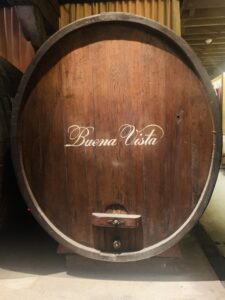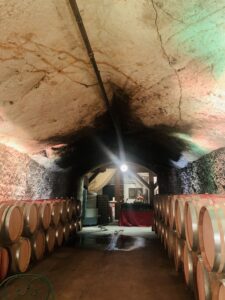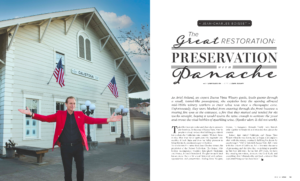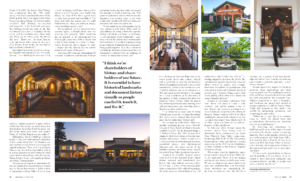
Napa Valley Life Magazine, March 2022
As Ariel Saland, our expert Buena Vista Winery guide, leads us through a small, tunnel-like passageway, she explains how the opening allowed mid-1800s winery workers to enter what was once a champagne cave. They were blocked from entering through the front because a roaring fire was at the entrance, a fire that they started and tended for six weeks straight, hoping it would warm the wine enough to activate the yeast and create the vital bubbles of sparkling wine. (Spoiler alert: It did not work).
Tales like these give color and character to present-day locations. In the case of Buena Vista, they tie us to a long-past era that laid the groundwork for modern-day California wine country. Without these stories, we may never appreciate the ingenuity and sacrifice it took Napa and Sonoma Valley pioneers to bring this world-renowned region to fruition.

No one knows this better than Jean-Charles Boisset, the proprietor of the Boisset Collection. The Boisset Collection encompasses wineries throughout California and France, Boisset’s homeland. The glamorous Boisset knows more than a bit about historical and cultural appreciation and preservation. Hailing from Vougeot, France, in Burgundy, Boisset’s family owns historically significant vineyards and wineries throughout the country.
Boisset first visited California and Buena Vista Winery when he was eleven, and he began a lifelong love affair with the winery, eventually fulfilling his dream by purchasing it. “I fell in love with Buena Vista, fell in love with the history of California, fell in love with the sense of pioneering and the idea that everything is possible in this beautiful state. In the last 150 years, we have the amazing innovators, pioneers, the Gold Rush, and everything that followed—the spiritual endeavor that says everything can be done here.”
Founded in 1857, the Buena Vista Winery was condemned after the 1989 earthquake, and Ariel described the state of the building with the champagne caves when Boisset purchased them, “It was in terrible condition. Had [Boisset] not restored and preserved it for historical purposes, the building would not exist at all. The recommendation was to resurface all the caves, and Jean-Charles said, ‘Absolutely not, there are no other caves like this in the area.’ These are the most historically significant wine caves in the state of California, if not in the US, and they’re high up there in the world.”
Specialized restorers carved each stone individually and regrouted them for earthquakes. The original grout was very rigid, and the building needed to wiggle and flow a little bit. The stones, so worn down that they leaked out as they filled the grout into the rocks, were each saved and reused. Today, all the building stones are original.
Maintaining historic buildings connects us to the past with physical reminders of what came before us. Boisset is understandably proud of the efforts made to keep the original structure. “How cool is it at Buena Vista, to say, that is how they built it, look at it, and we preserved it, and in three hundred years, that’s what we’ll see. Like the Louvre, Tulum, Machu Picchu, old temples in China, and Petra,” Boisset gushed.
As someone who grew up surrounded by and non-plussed by ancient history, Boisset may be the perfect person to bring a wave of restoration to Napa Valley. “I come from a world in Europe and France that you live where you live because your family has; where the maps of the wine regions have already been created and established. You must deal with the system and the walls built before you. Here, everything is unique, and everything can be yours.”
He recognized that the American wine country legacy, although short, was fascinating and inspiring. “What motivates me, in general, is the phenomenal idea that people came here with a dream and a world they wanted to create for themselves. Everybody has a chance to write a chapter [for the future], but we cannot erase the chapters of the past.”
Less than 200 years ago, winemaking did not exist in California as an industry. Pioneers and prospectors came here with dreams and the tenacity to build something new. This sense of exploration and innovation sets the American wine country apart in the wine world, and it melds well with two mainstays in Boisset’s life: wine and optimism.
“I was raised in an environment that is very serious [about wine]. That could be very stifling and boring. I think the opposite of that. I think we can have fun and learn. I don’t talk much about technicality. I have done it all my life, and we have mastered the technical side. It is not what is going to bring people together. Fermentation is not going to bring people together. It is about emotions and feelings. We have a phenomenal team of winemakers so that nobody can challenge us on wine. So that’s why we have fun!”
His infectious exuberance flows over as he waxes poetic about wine culture, French culture, and how he loves the big American smiles. His gregarious personality and success precede him, and he is well-known as a one-of-a-kind visionary and wine entrepreneur. Still, historical preservationist is becoming an oft-used descriptor, as he has made it his mission to help conserve the short but poignant history of Napa Valley. He does it by purchasing landmark sites, keeping their cultural importance, and restoring them to their former glory and beyond.
“The missionaries were sent to bring Catholicism; I was sent to bring the feeling that we’ve got to respect this incredible place that is California,” Boisset said.
He scooped up California’s oldest continually operating grocery store, Oakville Grocery & Wine Merchant, when it became available in 2019. On the National Register of Historic Places, the 1881 grocery store originally offered provisions to the first wine country adventurers. Today, it caters to a crowd interested in local artisanal products, wood-fired pizzas, and chef-prepared takeaway fare. The iconic nature of the building remains, but Boisset modernized it for today’s Napa Valley locals and travelers.
Adjacent to Oakville Grocery stands what used to be the founder’s home, which Boisset restored and transformed into Napa’s first wine history museum—1881 Napa Museum. A tour of the museum gives visitors a snapshot of the valley’s beginnings, the early pioneers, winemaking relics, and artifacts from the “Golden Age of Wine,” including original bottles from the 1800s. The part-winetasting-part-educational museum allows visitors to sample and compare wine from the valley’s 16 appellations. The concept falls in line with Boisset’s theory of preservation, “Preserve, bring back to what it was, adding a little twist of the future, but mainly keeping the past.”
Boisset is renovating Calistoga’s 1868 train depot and plans to open a cafe, brewery, and spirits tasting room on site. Boisset also recently purchased two more landmark properties—the Elizabeth Spencer Winery with its 1872 Post Office building that serves as its tasting room, and the Ink House Luxury Inn, which was built in 1885 and is now listed on the National Register of Historic Places.
In February 2022, Boisset opens the Chateau Buena Vista tasting room in downtown Napa, commemorating Buena Vista Winery’s Napa Valley connection. Partnering with Earth & Sky Chocolates, Boisset plans a wine and chocolate tasting experience in the 1929 Gordon Building—another building on the National Register of Historic Places.
When asked what he thinks the legacy of our current period in Napa Valley will be, he explained, “None of us are making average to poor wines, so that’s good news. We are entering an era where there is an excellent understanding and knowledge about viticulture and winemaking. So, we have transitioned over the last three decades into a period of extreme knowledge and savoir-faire. Now we are entering into a world of creativity and craft—a time of true artistry.”
Boisset reveals his respect for the wine pioneers, their innovations, and their dreams, and it is as if he is telling the stories of Napa Valleys’ roots for the first time with his fresh perspective. He compares Napa Valley’s progression to that of Burgundy and Bordeaux and shares that instead of taking centuries to build its legacy, Napa Valley will catapult to that level more rapidly by recognizing, protecting, and conserving its past earlier.
“California is new, [its wine country dates to] 1850. We always have this complex about Italy and France. Let’s write our own powerful history.”
By preserving and celebrating the buildings and history of the region to such a considerable extent, Boisset is ensuring himself a place in the appellation’s story as one of the pioneers who built Napa Valley. It is moving that a French vintner is so enamored with the Napa Valley of yesterday and today. He brings pride of place to the region and paves the way for an illustrious future.
“I think we’re shareholders of history and shareholders of our future. It is essential to have historical landmarks and document history visually so people can feel it, touch it, and live it.”






